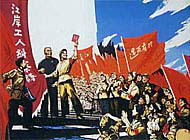The art and propaganda of woodblock prints

A new exhibition in Zurich tells the extraordinary story - through pictures - of how Chinese artists managed to develop individual styles during a period of minimal artistic freedom.
Entitled “Art and Propaganda” the exhibition covers the years 1940-1980, a period in China when uniformity and obedience to the party and state meant that artists were not only told what to do, but how to do it.
Illustrative woodblock – or woodcut – prints were their means of expression, a Chinese art form dating back well over 1,000 years to its origins during the Tang Dynasty, centuries before it was practiced in Europe.
The technique involves executing a design on paper, which is then pasted face down on to a section of wood. The back of the paper is sanded – or made translucent with water – until the image is transferred to the wood and can serve as a guide for carving.
The image in the wood is thus a negative or mirror image of both the original design and the picture to be printed.
“What makes this one different from our previous exhibitions,” says Alexandra von Przychowski of Zurich’s Rietberg Museum, “is that these art objects were created neither for galleries or museums. They were used for educational purposes or to put across a message to people who couldn’t read.
“They were put up on official notice boards or on walls in villages, and if you look closely you can see the perforations in the corners of the prints where they were pinned.”
Because the woodcuts were largely used for propaganda purposes, visitors to the exhibition might be tempted to ask whether they constitute art. Social-realism may not be to everyone’s taste, but there is no denying the creative skill of the artists who produced these prints, with their vivid use of colour and composition.
The exhibition, at the Rietberg’s Haus zum Kiel until June 24, came to Zurich from the Museum of Art at Ein Harod in Israel. Iris Wachs, who played a key role in its conception, told swissinfo that many of the prints are unique surviving examples of this art form in China.
“The Chinese have a tradition that printed material is reproduced and therefore not valuable. Many of the prints were displayed for a limited period and then thrown away, so these survivors are very valuable.”
It is difficult to imagine the conditions under which the artists worked. For example, during the Cultural Revolution between 1966 and 1971, few were permitted to create art that bore their own name. They were sent out to work on farms and in factories because artists, not being accustomed to manual labour, were regarded as intellectuals.
“They were dispatched to the village communes,” said Wachs. “But as well as working alongside and helping the farmers, they were also called upon to teach them art. So many of the works bearing the names of peasant workers were probably made with considerable input by the professional artists.”
Wachs says another reason why the pictures are interesting is that even in such circumstances, the professional artists developed individual styles. “Often you can locate the regions from where they came by looking at the prints,” she added.
Woodblock art, which was used by the Chinese for didactic purposes and propaganda long before the communist revolution, is still flourishing in China – at least in terms of quantity. “Whether it still has the same individuality and innovation,” said Wachs, “I’m not quite so sure.”
by Richard Dawson

In compliance with the JTI standards
More: SWI swissinfo.ch certified by the Journalism Trust Initiative
You can find an overview of ongoing debates with our journalists here. Please join us!
If you want to start a conversation about a topic raised in this article or want to report factual errors, email us at english@swissinfo.ch.